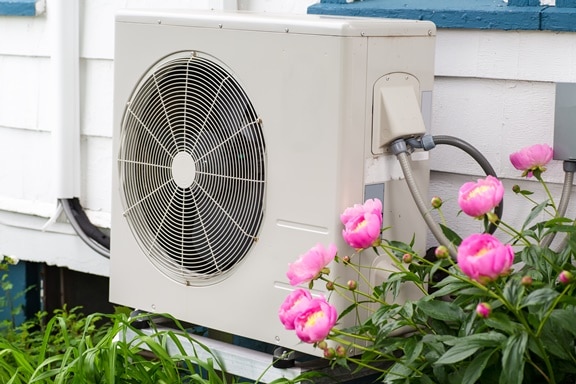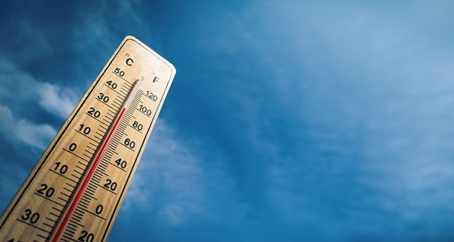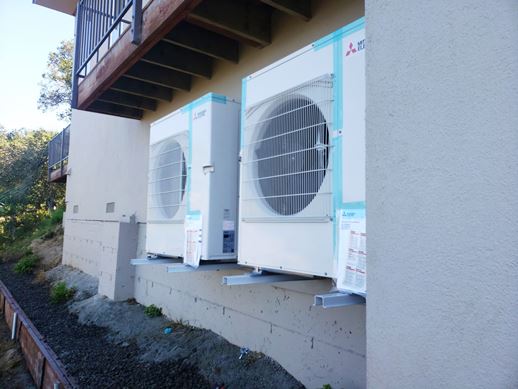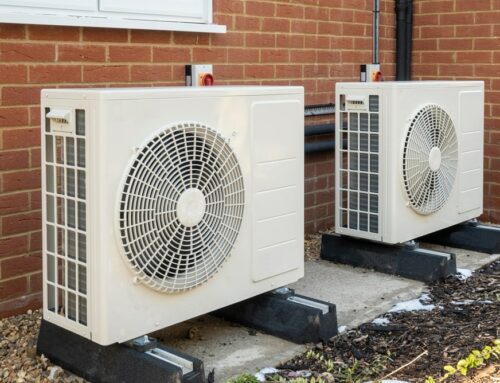Getting Technical (Again) about the Differences Between Heat Pumps and Furnaces
Considering a heat pump or want to know more about heat pumps? Santa Rosa CA based JW Hanson Heating and Air Conditioning are the North Bay experts. This post, the third in a series, is from Will Hanson as he discusses the technical aspects of heat pumps.

Many heat pumps are narrow with the fan or fans mounted vertically.
Your heat pump gets its energy from outside air. If you have been reading the previous articles, you know that by now. In simple terms, it’s the same principle as air conditioning in reverse. An air conditioner absorbs heat from the house and rejects it outside and a heat pump reverses that function.
This matters when you consider placement and arrangement of the outdoor portion of a heat pump system. An air conditioner may look similar, but the difference matters. You may notice that many heat pumps are narrow with the fan or fans mounted vertically.
This allows the air to blow away from the outdoor unit sideways. The conventional air conditioner format blows the air straight up. When you are cooling your home, the heat absorbed is rejected outside. As a result, the air coming off the heat exchanger of the outdoor unit is warmer than the ambient air. This warmer air rises and away as it is displaced by the cooler, heavier air around it.

This is another situation where you must set aside your perception of warm and cold. We are talking about relative heat. If you’re running your air conditioner, it’s probably what we would consider “hot” outside.
If it is 85 degrees outside and the air conditioner is running, the air coming off the fan is going to be at least 10 degrees warmer.
This difference causes the relatively cooler 85-degree air to displace the warmer air up and out of the way. The blower that is pushing the air up is amplifying this displacement and the two are working together to move the heat away from the outdoor coil.
If we paint the same picture with the heat pump, the situation is reversed. Now it is 45 degrees outside, and the heat exchanger is pulling heat energy from that air. This means, off the top, the air coming off the blower is at least 10 degrees cooler than the ambient air. As we know, cooler air is heavier air.
This presents a significant problem. The colder air is going to fall back down to the area around the unit. As the outdoor units are generally placed alongside the home, a significant amount of this colder air will pool around the unit and be drawn back in. This negatively impacts the performance of the equipment.
 A heat pump with a horizontal discharge has less of a problem with this situation than it vertical discharge countertype. However, it is important to allow a lot of space around the unit, especially in front, to allow the colder air to escape.
A heat pump with a horizontal discharge has less of a problem with this situation than it vertical discharge countertype. However, it is important to allow a lot of space around the unit, especially in front, to allow the colder air to escape.
If the unit is placed in a narrow side yard or in an area that slopes back to the house, the same problems could arise.
The easiest way to remedy this issue is to raise the unit up on wall brackets or a concrete pedestal, depending on the location, to get it away from the cold air pooling below it.
 A final note about cold air and condensation. If the outdoor unit is placed on a concrete slab that is part of a walkway or patio, that slab is going to get wet around the unit. This can become a hazard as consistently wet concrete will allow algae-like growth and will freeze if the ambient temperature is low enough. Both can easily result in a slip and fall.
A final note about cold air and condensation. If the outdoor unit is placed on a concrete slab that is part of a walkway or patio, that slab is going to get wet around the unit. This can become a hazard as consistently wet concrete will allow algae-like growth and will freeze if the ambient temperature is low enough. Both can easily result in a slip and fall.
Heat pumps are the future, but there are certainly a lot of things that must be understood regarding the difference between them and the more conventional forms of heating using fossil fuel.



